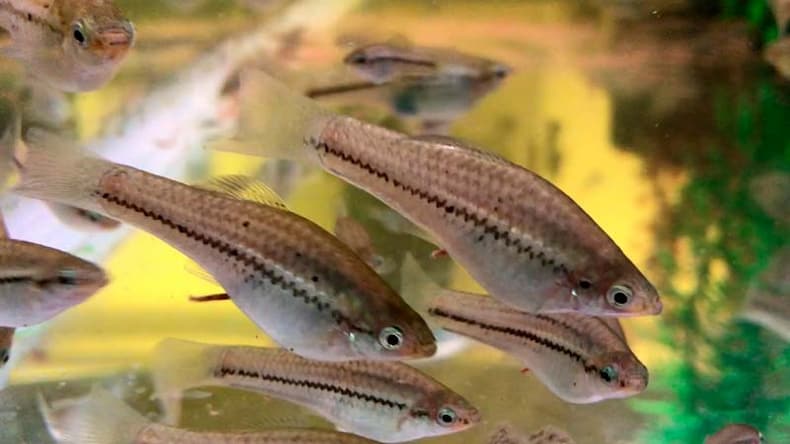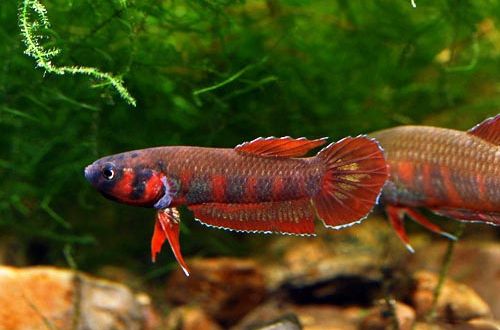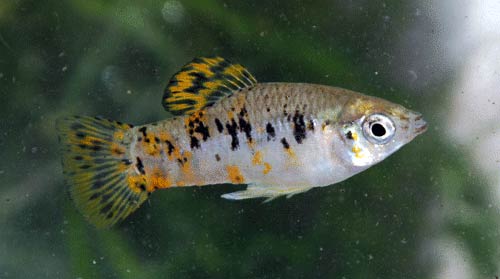
Montezuma’s swordsman
Montezuma’s swordtail, scientific name Xiphophorus montezumae, belongs to the Poeciliidae family. The fish was discovered in 1899 in the Moctezuma River basin during the expedition of scientists Jordan and Snyder to Central America. For the unique structure of the tail, she was nicknamed the “King of the Sword”.

Contents
Habitat
The natural habitat extends to the northeastern regions of modern Mexico. Inhabits numerous river systems flowing down hilly terrain into the Gulf of Mexico. It is found along the coastline among dense thickets of aquatic plants.
Brief information:
- The volume of the aquarium – from 50 liters.
- Temperature – 20-26°C
- Value pH — 7.0–8.0
- Water hardness – soft to medium hard (5-18 dGH)
- Substrate type – any
- Lighting – moderate or bright
- Brackish water – yes, at a concentration of 5-10 grams of salt per 1 liter of water
- Water movement – light or moderate
- The size of the fish is 4–5 cm.
- Food – any food
- Temperament – peaceful
- Content alone, in pairs or in a group
Description
Adult males reach a length of 4–5 cm, excluding the tail, which, due to the elongated lower rays (the same “sword”), can be twice the size of the fish itself. The color is silvery with yellow or greenish tints. The body pattern includes several black speckles with the greatest concentration on the dorsal fin.

The females are similar in size, but the coloration is less bright. The main color is grey. A black stripe runs along the body, stretching from head to tail. The females lack the characteristic sword.
Food
Accepts all types of food intended for aquarium fish. The daily diet may consist of dry flakes, pellets, combined with live or frozen brine shrimp, bloodworms, daphnia and other invertebrates.
Maintenance and care, arrangement of the aquarium
The optimal size of the aquarium for 4-5 fish starts from 100 liters. The design should provide places for shelters, for example, thickets of living plants, branched snags, artificial decorative objects.
Montezuma’s swordsman is easy to keep. It is important to provide a slightly alkaline hydrochemical composition of water with medium or high hardness values (dGH). Weekly replacement of part of the water with fresh and uninterrupted operation of the filtration system will keep the level of organic pollution at a low level.
It is recommended to provide a moderate internal current to simulate the flow of water in a river. A productive internal filter will cope with this task.
Behavior and Compatibility
Males are temperamental and compete with each other for territory and the attention of females. In a small aquarium, it is desirable to maintain a harem-type group consisting of one male and several females.
Peacefully tuned in relation to other species. Compatible with many freshwater fish of comparable size and temperament.
You can not settle together with species that are prone to bite off or damage other people’s fins. For example, this behavior is characteristic of some barbs.
Breeding / breeding
Under favorable conditions and a balanced diet, spawning can occur every 4–6 weeks. That’s how long the incubation period is. Swordtails do not lay eggs, but give birth to fully formed fry. The brood size of one female averages 10–30 pieces. An hour after birth, they are ready to take their first meal. Since parental instincts are not developed, there is a threat of predation of adult fish in relation to their own juveniles.
Fish diseases
The likelihood of the disease increases when the fish are kept in an unsuitable environment, poor nutrition and injury. Under normal conditions, cases of the disease are rare. Read more about symptoms and treatments in the Aquarium Fish Diseases section.





